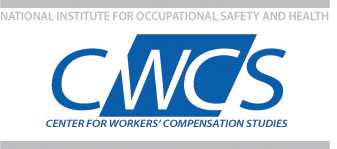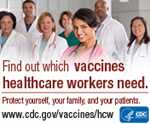TWH™ in Action!
Volume 2 Number 3 August 2013

In this issue:
- Managers’ Buzz
- TOTAL WORKER HEALTH™ Exclusive
- Promising Practices for TOTAL WORKER HEALTH™
- Updates from NIOSH Centers of Excellence to Promote a Healthier Workforce
- News from our Partners
- New Initiatives and Resources
- TWH Fast Facts
- Coming Soon! Are You Ready for the New Health Insurance Marketplace?
- Upcoming Conferences, Webinars and Trainings in Support of NIOSH TOTAL WORKER HEALTH™
Managers’ Buzz
BY:ANITA L. SCHILL, PhD, MPH, MA AND L. CASEY CHOSEWOOD, MD

In May, the 10th International Conference on Occupational Stress and Health elevated the significance that work and health cannot be separated. Underscoring an emerging research area and priority for NIOSH, the conference was themed Work Stress and Health 2013: Protecting and Promoting Total Worker Health®. Nearly 800 professionals from 39 countries, representing academia, labor, and industry participated in the biennial event sponsored by NIOSH and partners at the American Psychological Association and the Society of Occupational Health Psychology.
Of special interest, we learned that we were not alone in our commitment to integrate health protection with health promotion. We were inspired by the numerous papers and posters from around the world that presented on the benefits and design of integrated prevention practices that promote overall worker well-being. We are proud to share this commitment at a critical point in a new area of research and practice in workplace safety and health. As the concept of Total Worker Health continues to get wider attention, we look forward to future collaborations with our colleagues. To learn more about WSH2013, read the Director’s Desk in the August 2013 issue of NIOSH eNews: /niosh/enews/enewsV11N4.html#director

This issue of TWH® in Action! is full of the latest news in TWH. Start by learning the cutting-edge developments on Privacy and Security of Employees’ Health Data in the Era of Electronic Health Records in our Total Worker Health Exclusive. In Promising Practices for TWH, gain insight into how an academic medical center with over 8,000 employees in need of healthier organizational changes takes on an integrated approach. In New Initiatives and Resources, discover exciting new expansions on the NIOSH TWH Web Page. For example, on Perspectives on Total Worker Health, we provide a set of select papers that provide theoretical and conceptual commentaries on the integration of health protection and health promotion. We also provide frameworks and strategies for implementation, including issues related to planning, management systems, and evaluation on Guidelines for Implementing Total Worker Health Programs. On Resources for Select Worker Health, Safety and Well-being Programs, you will find a set of select resources that provide frameworks and directions that discuss characteristics of comprehensive programs, including the integration of health protection and health promotion. In addition to these highlights, get more of the latest TWH updates in NIOSH Centers of Excellence to Promote a Healthier Workforce, News from Our Partners, and Upcoming Conferences, Webinars and Trainings.
As always, we hope this newsletter inspires you to become a Total Worker Health® advocate. Share your comments and stories about TWH® in Action! with us on Twitter (@NIOSH_TWH®), on the NIOSH Total Worker Health® LinkedIn Group, or send us an email at TWH@cdc.gov.
Total Worker Health® Exclusive
Privacy and Security of Employees’ Health Data in the Era of Electronic Health Records
BY:KERRY SOUZA, SCD, MPH; CAPT MARGARET S. FILIOS, SM, BSN; AND EILEEN STOREY, MD, MPH
Big Data, Little Data, Open Data – a burgeoning interest in data is evident, perhaps nowhere more so than in public health and healthcare. Nationally, several major ‘data revolutions’ are underway, including a transition to Electronic Health Records (EHRs) to maintain and share longitudinal patient health data, and the increasing use of data to measure the performance of healthcare and public health programs. Both trends are relevant to Total Worker Health: data are being used in new and innovative ways to measure employee health status and increasingly, occupational health data are being exchanged electronically.
As employers, labor, public health and other stakeholders work together to integrate health protection and health promotion in the workplace, the amount of employee health data being generated, collected and electronically exchanged will only increase. Have you ever wondered what happens to employee wellness data collected by employers or a third party? Are these data treated as ‘confidential?’ Who has access to the data? When an employer has both voluntary wellness and required screening programs for employees, how should the data be maintained to prevent accidental disclosure of the voluntary information? These and other questions emerge when new employee health programs are put in place and/or paper records are replaced by electronic systems.
How to provide protection for personal health data is an important question. In 2000, the HIPAA Privacy Rule set new expectations for handling health data, but health data collected by employers may not be covered by the Privacy Rule, which pertains to “covered entities” who bill for clinical services. In some cases, provisions of Workers’ Compensation Laws or the American with Disabilities Act may govern handling of employees’ health data. EHRs enable both unprecedented exchange and secondary (e.g., research) use of health data, calling for a renewed analysis of the regulations and policies that protect those data. EHRs can also be part of the solution. Health information technology offers tools that can be employed to control access to employee’s personal health information. Best practices for the use of these tools in supporting TWH will be valuable to all stakeholders.
The NIOSH Electronic Health Records Working Group began exploring these issues and others at a June workshop on “Ethical and Privacy Challenges: Managing Information in Electronic Health Records in the Context of Occupational Health.” Representatives from Federal and state government; healthcare organizations and provider groups; the insurance industry; organized labor; and, the HHS Office of the National Coordinator for Health Information Technology (ONC) participated. The ONC provided observations based on their experience addressing privacy and security challenges and opportunities encountered in the transition to EHRs.
Workshop proceedings and other outputs will help stakeholders identify opportunities to protect employee health data while providing integrated healthcare to workers. The NIOSH EHR Working Group and the TWH Team will work together with our partners and stakeholders to address privacy and security issues in this new landscape of data use. Workshop proceedings and other outputs will help stakeholders identify opportunities to protect employee health data while providing integrated healthcare to workers. The NIOSH EHR Working Group and TWH will work together with our partners and stakeholders to address privacy and security issues in this new landscape of data use. For those who may wish to find out more, the Institute of Medicine has released a report entitled “Incorporating Occupational Information in Electronic Health Records: A Letter Report,” available at http://www.nap.edu/catalog.php?record_id=13207.
Promising Practices for Total Worker Health®
In Promising Practices for Total Worker Health® we share with you examples of how employers from across the country and from a wide range of industries are taking steps to integrate both health promotion and health protection in their workplaces.
If your organization is proactively integrating health protection and health promotion to prevent injury and illness and advance the well-being of your workers, please email us at TWH@cdc.gov.
Disclaimer: The mention of organizations and commercial entities and products in this article is for illustrative purposes only and does not represent an endorsement by NIOSH, CDC or the US Department of Health and Human Services.
Health, Safety, and Well-Being: Corporate Strategy at Dartmouth-Hitchcock
BY:CHIA CHANG, MPH, MBA, PUBLIC HEALTH ANALYST, NIOSH

Photo source: Dartmouth Hitchcock Medical Center
In 2009, Dartmouth-Hitchcock, an academic medical center in New Hampshire with over 8,000 employees, needed to make a change. Covering over 16,000 in its health plans, health care costs were almost 10% of the medical center’s budget and rising faster than health care inflation rates each year. While collaborative, the employee health and safety departments were in different silos and recognized there were opportunities to create synergies with each other’s initiatives. Another challenge was that the medical center had different locations and clinic sites.
The leadership of Dartmouth-Hitchcock decided that it could do better and would aim to have the healthiest workforce possible—a goal which the medical center adopted as the corporate vision to ensure sustainability and engagement at every level. As a result, the strategic priority, Live Well/Work Well (LWWW), was created with a mission to create a culture of health, safety, and well-being.
Integrating Safety and Health
A foundational principle of LWWW is that the health of employees is facilitated by integration of health protection with health promotion. LWWW developed electronic reporting of injuries (EROI), which assures timely medical care by providing immediate notification to employer stakeholders such as occupational medicine, safety, human resources, and work ability programs. LWWW also identified high-risk work units using aggregate EROI data and assessed their need for health promotion and protection interventions. The work units were evaluated by wellness and performance indicators, including Health Risk Appraisal (HRA) participation, patient satisfaction, culture of health, and nursing quality.
Comprehensive Assessments
If a work unit meets criteria for an intervention, a Safety Wellness Action Team (SWAT) is to be formed, a new initiative now being piloted by LWWW. Then the Team will conduct an initial, open-ended safety and socio-environmental assessment of work organization, leadership, leadership support for culture of health, physical hazards, indoor air quality, ergonomics, whole worker health, nutritional environment, and opportunities for physical activity at work. The local Partners in Health, Environment, Wellness, and Safety (PHEWS) committee, comprised of stakeholder representatives from the work unit, will review and discuss the results. If needed, the PHEWS committee will help other employees in the work unit participate in a self-scored, psychosocial and personal health surveys looking at issues such as burn out, depression and anxiety, perceived stress, and physical well-being.
Individual and Organizational Interventions
On an individual level, employees use the self-scored surveys, which are not turned in, to understand the resources available to them. Services include employee assistance and behavioral health; work ability programs; and primary care disease management. At the group level, the PHEWS Committee identifies resources that would be helpful to the work unit as a whole. For example, administrative support staff may have limited opportunities for physical activity, so a health coaching intervention may be provided for the entire group. Integrated SWAT interventions include supervisor training, team and resiliency building, chaplaincy, lifestyle coaching, benefits design, and environmental supports, such as access to healthier foods or changes to work schedules, and policy changes.
Metrics for Whole Worker Health
The integrated approach of LWWW applies to not only the needs assessment and interventions, but also the measurement of employee safety, health, and well-being. LWWW uses multiple metrics for its program evaluation. Illustrated in figure 1, metrics are included for occupational safety and health, health outcomes, business outcomes, work environment, program delivery and health risks. Aside from looking at the of data for the entire workforce population, as more time passes, the LWWW program intends to capture changes in the health outcomes and health care costs for cohorts of employees.
Figure 1. LWWW Program Evaluation Metrics
Occupational Safety and Health
|
Health Outcomes
|
Business Outcomes
|
Work Environment
|
Program Delivery
|
Health Risks
|
Culture of Health, Safety, and Well-Being
Dartmouth-Hitchcock continues to strive toward its vision of having the healthiest workforce possible. This year, the medical center incorporated into their performance management process the expectation that each employee has a responsibility for creating a healthier and safer work environment. The goals and expectations for each employee vary, ranging from a new employee’s simply gaining awareness of health and safety policies to a senior leader’s creation of effective policies that improve employee health.
Health, safety, and well-being are integral to how Dartmouth-Hitchcock conducts its business. By operationalizing the value of health and safety, the medical center is working to drive the sustainability of its health system as well as its culture of health.
Updates from NIOSH Centers of Excellence to Promote a Healthier Workforce
The Center for the Promotion of Health in the New England Workplace (CPH-NEW)
Congratulations to the CPH_NEW Co-Director, Laura Punnett, Sc.D., who was named University Professor at the University of Massachusetts Lowell. To learn more about the appointment, click here.
On October 17, 2013, CPH-NEW will co-sponsor “Health, Workplace, and the Environment: Making Connections” at the University of Connecticut Storrs Campus. Dr. John Howard, Director of NIOSH, will provide opening remarks at the meeting. During the afternoon session of this meeting, CPH-NEW pilot grantees will serve as panelists for a Research to Practice Forum. For more information, contact CPH-NEW investigator and Conference Chair, Pouran.Faghri@uconn.edu.
The CPH-NEW Healthy Worksite Participatory Program online toolkit for workplace safety and wellness managers will be available in Fall 2013. Join the CPH-NEW Mailing List to receive announcement of webinar training dates: www.uml.edu/cphnew.
Harvard Center for Work, Health and Well-being
The Harvard School of Public Health Center for Work, Health, and Well-being (CWHW) announces a continuing education course on Total Worker Health® approaches for professionals and practitioners. “Work, Health, and Well-Being: Integrating Wellness and Occupational Health and Safety in the Workplace” will be held January 27 – 29, 2014 in Boston, MA. This program provides participants with the skills necessary to evaluate the effectiveness of workplace health strategies, translate this evidence into practice, and implement these strategies to design worksite health protection and promotion programs. Participants learn to integrate occupational health, safety, and wellness into a comprehensive program that enhances the overall health and well-being of the workforce and reduces work-related injuries and illnesses. This is an applied program intended for professionals engaged in workplace health promotion, occupational health and safety, human resources, and related fields involved in worker health, wellness, and productivity management. For more information about the program and agenda visit the website.
University of Iowa Healthier Workforce Center for Excellence (HWCE)
Stay connected with the UI Healthier Workforce Center for Excellence through the Healthier Workforce e-Bulletin. The monthly newsletter promotes evidence-based information and Total Worker Health® strategies to smaller employers looking to build a safer and healthier workforce. View past issues and sign up here.
The HWCE also shares information and resources through social media on Pinterest, Twitter, and Facebook. Join and get up-to-date resources that help support and complement Total Worker Health® programs.
Oregon Healthy Workforce Center (ORhwc)
View course materials from the OHWC’s short course: Creating Excellence in Worksite Wellness: Taking your Program to the Next Level from the Oregon Governor’s Occupational Health & Safety Conference held in March 2013.
Webinar, Sleep and Shift Work: Impact of Health, Safety, and Productivity, from Oregon Healthy Workforce Center of Excellence now available for download.
News from our Partners
CDC partners with 104 employers for National Healthy Worksite Program: Initiative aims to prevent chronic disease, improve worker productivity, and control health costs
The Centers for Disease Control and Prevention, through its partner Viridian Health Management, has identified 104 employers in eight counties across the nation to participate in the National Healthy Worksite Program, a new initiative aimed at reducing chronic disease and building a healthier, more productive U.S. workforce. The initiative primarily focuses on small and mid-sized employers.
CDC’s National Healthy Worksite Program is supported through the Affordable Care Act’s Prevention and Public Health Fund, and is designed to assist employers in building successful workplace wellness programs by implementing science-based disease prevention and wellness strategies to help reduce chronic diseases. All program and implementation support to participating employers will be provided by Viridian Health Management over a 12-month period. Viridian was selected as an implementation partner through a competitive process.
“Employers can increase productivity, cut health care costs and reduce the burden of heart disease, cancer, stroke, diabetes and other health problems in their workforce by making it easier for employees to be physically active, eat healthy foods, and not smoke,” said CDC Director, Tom Frieden, MD MPH. “Our National Healthy Worksite Program is providing valuable tools to help employers create effective workplace wellness programs that will benefit employees and their families, their community, and the nation as a whole.”
The eight participating communities are Buchanan County, Mo.; Harris County, Texas; Kern County, Calif.; Marion County, Ind.; Philadelphia County, Pa.; Pierce County, Wash.; Shelby County, Tenn.; and Somerset County, Maine.
The communities were selected because of their high rates of chronic diseases, smoking and physical inactivity. Also important in the community selection process was the availability of local resources to support a sustainable workplace health program, such as proximity to hospitals and existing community health promotion programs.
Employers in the eight communities were chosen based on interest and industry diversity. Each business will receive intensive support and expertise in developing a combination of interventions. Employers can choose which strategies to implement that support physical activity, good nutrition, and tobacco-use cessation. Examples of strategies include:
- Nutrition counseling/education, worksite farmer’s markets, menu labels on healthy foods in vending machines and cafeterias, access to healthy foods in cafeterias and vending machines, and weight management counseling.
- Tobacco-cessation counseling (including quit lines and health plans) and tobacco-free campus policy.
- Physical fitness and counseling, and walking clubs.
At the end of the program, a national evaluation will document best practices for successfully implementing workplace health programs in small worksites more broadly.
The Center for Promotion of Health in the New England Workplace (CPH-NEW), one of the NIOSH-funded Centers of Excellence to Promote a Healthier Workforce, plays an important role in the program as a subcontractor to Viridian. CPH-NEW is providing expertise and consultation to health coaches, employers, and workplace champions related to assessing job health and safety risks and interventions that integrate health promotion initiatives with safety initiatives.
The Center also manages a data center that conducts analyses of both company-level and the (de-identified) individual level, as well as builds upon existing work with its Research-to-Practice Toolkit to assess workplace risks and environmental resources in relation to ergonomics, job stress, and safety culture. Stay tuned for more information on these assessment tools the NIOSH Total Worker Health® website.
For a complete listing of the selected employers and more information about the program, visit: /NationalHealthyWorksite.
New Initiatives and Resources
Discover new expanded resources for TWH on the NIOSH TWH Web Page. In Perspectives on Total Worker Health, you will find a set of select papers that provide theoretical and conceptual commentaries on the integration of health protection and health promotion. Learn about frameworks and strategies for implementation, including issues related to planning, management systems, and evaluation in Guidelines for Implementing Total Worker Health Programs. In Resources on Comprehensive Worker Health, Safety and Well-being Programs you will find information on characteristics of comprehensive workplace safety and health programs, including the element of integration of health protection and health promotion.
Get Ready for the New Health Insurance Marketplace
Beginning October 1, millions of Americans will have a new way to find affordable health coverage–including many free preventive services– on the new Health Insurance Marketplace. The Marketplace will offer Americans a whole new way to shop for health insurance to gain greater access to affordable services such as physician visits, preventive care, hospital stays, and prescriptions. Through the same streamlined application process, many will find out if they are eligible for Medicaid or the Children’s Health Insurance Program (CHIP) at the Marketplace. Community health centers and other organizations will be funded to help consumers navigate the new Marketplace. Consumers can learn more about the Marketplace now and get ready to enroll by visiting HealthCare.gov or the Spanish-language site CuidadoDeSalud.gov or by calling the new 24-hours-a-day consumer call center at 1-800-318-2596. Hearing impaired callers using TTY/TDD technology can call 1-855-889-4325 for assistance.
New editions of Healthy Hospital Practice to Practice Series (P2P) available:
As major employers and health leaders, hospitals can help establish strong community norms for promoting healthy and active living through nutritious food and beverages, opportunities for physical activity, support for breastfeeding, and tobacco-free environments. In the latest editions of the P2P Series, learn how Davis Memorial and Georgetown University Hospitals are improving access to private spaces for employee lactation . Also, read how LSU Health Systems and University of Kansas Medical Center improve support for tobacco-free hospital campuses . For these reports and more, visit: /nccdphp/dnpao/hwi/resources/hospital_p2p.htm
New National Health Interview Survey-Occupational Health Supplement Topic Page Provides Industry-Specific Data:
Prevalence rates of work-related health conditions, work organization factors, and occupational psychosocial and physical/chemical exposures among U.S. workers by industry sector and occupational category are now available on the new National Health Interview Survey Occupational Health Supplement topic page.
The data obtained from the 2010 National Health Interview Survey (NHIS) Occupational Health Supplement (OHS), are organized into National Occupational Research Agenda (NORA) Sector Profiles. These profiles each contain charts and tables describing the prevalence of 14 outcomes. Results are categorized by industry and/or occupation subgroups within each sector profile. In addition to the sector profiles available on the NHIS-OHS topic page, summaries of the 14 health outcomes by demographic characteristics as well as broad industry and occupation categories are available.
Using these data, industry stakeholders can prioritize industry-wide interventions and employers can prioritize organization-level interventions to help ensure that the most pressing industry health concerns receive the appropriate attention. For example, 10% of non-smoking workers employed in all industry sectors combined reported regular exposure to secondhand smoke at work; but, the prevalence of exposure was more than twice that high among workers in the mining and oil and gas extraction, construction, and public safety sectors.
NIOSH will sponsor another NHIS-OHS in 2015, which will include most of the 2010 questions in order to monitor trends over time but may include a few new questions to address other high priority topics To read more and provide feedback, visit the NIOSH Science Blog.
NIOSH Center for Workers’ Compensation Studies

NIOSH recently created the Center for Workers’ Compensation Studies (CWCS) to use workers’ compensation (WC) data to prevent and reduce the severity of work-related injuries and illnesses.
The CWCS will coordinate research by NIOSH researchers and will work with external partners to maximize the use of their own WC data. The Center’s goals are to integrate WC data with other health-related data to understand the full economic impact of work-related injuries and illnesses and to identify evidence-based holistic prevention strategies. This includes health protection, health promotion, and disability management approaches. More information about the CWCS, including goals, current studies, and partnerships can be found at /niosh/topics/workerComp/CWCS/
Types of workers' compensation data
- Claims Information: Workers’ compensation claims may be filed after a worker is injured or becomes ill due to their job. Claims include the nature of injury/ illness, how the injury/ illness occurred, the type and cost of medical care received, cost of partial wage replacement, the number of days off work, and injured worker characteristics (occupation, age, gender, time with the employer, etc.).
- Employer Information: Insurers and employers collect data on the types of hazards present in the workplace, safety/ health programs and controls in place to prevent injury/ illness and return-to-work programs to reduce injury/ illness severity.
TWH® Fast Facts:
August is National Immunization Awareness Month (NIAM). NIAM is the perfect time to promote the importance of immunizations and remind family, friends, and co-workers to get caught up on their vaccinations (shots). It is always better to prevent a disease than to treat it.
CDC develops immunization materials our partners can use in local outreach and education efforts during NIAM and year-round. Check out CDC Resources for National Immunization Awareness Month to see links to materials that can be used during NIAM.



Upcoming Conferences, Webinars and Trainings in Support of NIOSH Total Worker Health®
Past Speaking Engagements
Alicia Kurowski, Sc.D., Post-Doctoral Research Fellow at The Center for the Promotion of Health in the New England Workplace (CPH-NEW), presented “Physical and psychosocial health effects of nursing home staff responsible for unpaid care work” at the 8th International Scientific Conference on Prevention of Work-related Musculoskeletal Disorders (PREMUS), July 2013 in Busan, Korea.
Dr. L. Casey Chosewood presented “An Overview of NIOSH Total Worker Health” on July 24, 2013 during the Mine Safety and Health Research Advisory Committee Meeting in Pittsburgh, Pennsylvania.
Dr. Laura Punnett from The Center for the Promotion of Health in the New England Workplace (CPH-NEW) presented “Random effects models of back pain among nursing home workers” at the 8th International Scientific Conference on Prevention of Work-related Musculoskeletal Disorders (PREMUS) July 2013 in Busan, Korea.
Dr. Laura Punnett from The Center for the Promotion of Health in the New England Workplace (CPH-NEW) presented “The impact of workplace factors on filing of workers’ compensation claims by nursing home workers” at the 8th International Scientific Conference on Prevention of Work-related Musculoskeletal Disorders (PREMUS), July 2013 in Busan Korea.
Dr. L. Casey Chosewood presents “An Occupational Professional’s Guide to Total Worker Health” at the Miller Coors and Harley Davidson Joint Occupational Health Conference in Milwaukee, WI on August 13, 2013.
Upcoming Speaking Engagements
Dr. Jennifer Hall, Outreach Director for the University of Iowa Healthier Workforce Center for Excellence, will present a breakout session on “Creating a Healthy Workplace on a Limited Budget” and serve as a panelist addressing best practices at the upcoming Quad Cities Community Workplace Wellness Workshop on September 10, 2013 in Moline, IL.
Nicholas Warren, Sc.D., investigator at The Center for the Promotion of Health in the New England Workplace (CPH-NEW), will present “Ergonomics and Wellness Together: Tools and Resources for Total Worker Health” at the 2nd Annual Wellness Conference of the Worksite Wellness Council of MA on September 17, 2013 in Westford, MA.
Dr. Kent Anger, Director of the Oregon Healthy Workforce Center, will moderate the session “Total Worker Health” at the Western States Occupational Network (WestON) Sixth Annual Meeting in Golden, CO on September 26, 2013. Ms. Chia-Chia Chang will speak during the session on the topic “Integrating Health Protection and Health Promotion.”
Dr. L. Casey Chosewood will speak at the American Occupational Health Professionals in Healthcare Annual Conference in Orlando, Florida on the topic of “Optimizing Total Worker Health®” in September 2013
NIOSH Director Dr. John Howard will provide the opening address of the Health, Workplace, Environment: Cultivating Connections Conference hosted by the University of Connecticut in Storrs, Connecticut on October 17, 2013.
Jim Merchant, Center Director of for the University of Iowa Healthier Workforce Center for Excellence, will present “Statewide Employer Survey Regarding Adoption of Elements of the IOM Employee Total Health Management Model” at the 141st American Public Health Association (APHA) Annual Meeting held November 2-5, 2013 in Boston, MA.
All four NIOSH Centers of Excellence to Promote a Healthier Workforce will participate in a Total Worker Health® Panel Presentation on November 4, 2013 for the 141st APHA Annual Meeting in Boston, MA.
Dr. L. Casey Chosewood will be presenting “An Introduction to Total Worker Health®” at the US Southeastern Mine Safety and Health conference on November 6, 2013 in Birmingham, Alabama.
Dr. Diane Rohlman, Associate Director and Dr. Jennifer Hall, Outreach Director of the University of Iowa Healthier Workforce Center for Excellence, will present a breakout session on “Integrating Total Worker Health® in Small Businesses: Success Stories” at the Iowa Governor’s Safety & Health Conference on November 7, 2013 in Cedar Rapids, Iowa.
Conferences and Webinars
2nd Annual Wellness Conference of the Worksite Wellness Council of Massachusetts at the Westford Regency Inn Conference Center in Westford, MA on September 17, 2013. Register at www.wwcma.org. For more information, contact CPH-NEW Outreach Director and Conference Chair, Suzanne_Nobrega@uml.edu.
Harvard Center for Work, Health, and Wellbeing: Strategic Solutions for Integrating Wellness and Occupational Safety and Health in the Workplace to be held January 27-29, 2014 in Boston, MA. Participants will learn to integrate occupational health, safety, and wellness into a comprehensive program that enhances the overall health and wellbeing of the workforce and reduces work-related injuries and illnesses.
SAVE THE DATE! Work, Stress and Health 2015: Sustainable Work; Sustainable Health; Sustainable Organizations will be held at the Westin Peachtree Plaza in Atlanta, GA, on May 7-10, 2015.
Please send your comments and suggestions to us at TWH@cdc.gov
Get Email Updates
To sign up to receive the TWH Newsletter, enter your email address:
- Page last reviewed: August 27, 2015
- Page last updated: August 27, 2015
- Content source:
- National Institute for Occupational Safety and Health Office of the Director
TOTAL WORKER HEALTH ® is a registered trademark of the US Department of Health and Human Services


 ShareCompartir
ShareCompartir